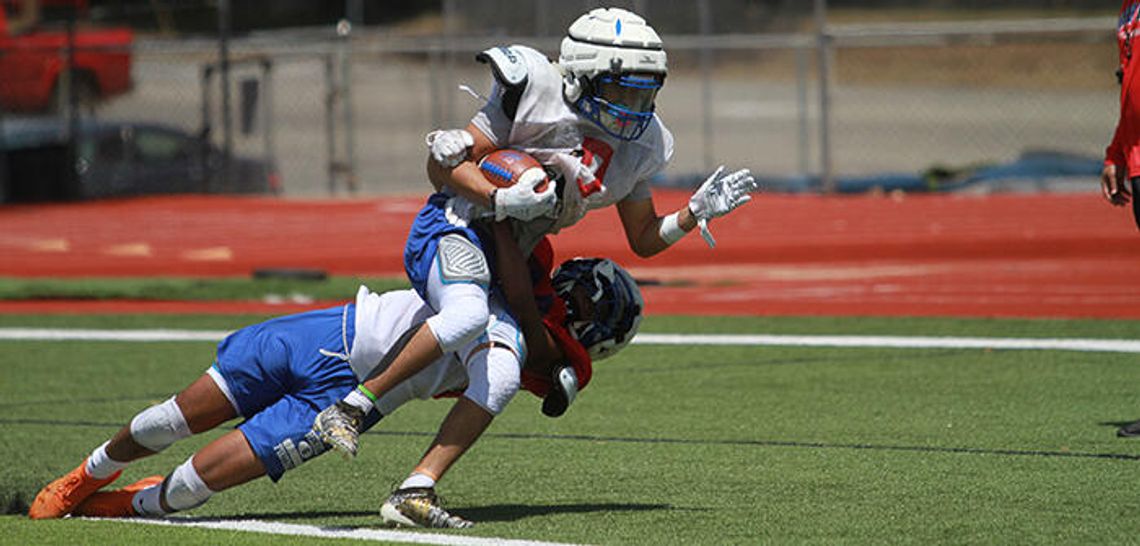Part space-age technology, part composite foam, a new device purchased for use by Hays CISD high school football teams aims to reduce the severity of impacts to the head.
Over the summer, Hays CISD leaders purchased protective helmet covers amounting to $11,078. The helmet covers, made by Georgia-based company Guardian, are used by more than 100 colleges and more than 1,000 high schools, according to the company’s website.
While experts in sports medicine feel the padding is the right step toward improving player safety, most agree the devices still won’t completely take concussions out of the game.
Over the summer, Hays CISD leaders purchased protective helmet covers for $11,078. The helmet covers, made by Georgia-based company Guardian, are used by more than 100 colleges and more than 1,000 high schools, according to the company’s website.
The cover, which is fixed over the player’s helmet, is meant to mitigate repetitive, cumulative blows to the head. According to the Guardian website, the padded cover is estimated to reduce impact by up to 33 percent.
Hays CISD players are mandated to wear the helmet covers during practices only, but do not wear them during games.
Mark Winter, Hays High head athletic trainer, said the padding is primarily meant to limit the number of sub-concussive blows to the head football players might experience.
A sub-concussive blow is a hit that falls below the threshold of an actual concussion. A concussion is a mild traumatic brain injury that occurs when an impact of the head or body causes the brain to shift or move inside the skull.
Winter said sub-concussive hits or blows typically happen while players are at practice. The more sub-concussive hits or blows a player takes, the more an athlete could suffer a concussion.
“The main thought is that practice time is when you’re usually getting more continuous hits,” Winter said. “You’re working on blocking more and tackling more and there’s more chances to get a sub-concussive blow.”
Katherine Labiner, M.D, a child neurologist with Child Neurology of Austin, said the overall intent about the padded device is to diffuse and slow down the velocity of a hit to the head. Labiner said the devices are growing in popularity among parents who have chosen to buy them for their kids. Hays CISD is one of the first districts in the area to purchase the caps on a wide scale for all high school athletes.
However, Labiner said the caps are still controversial in terms of their effectiveness.
Labiner said the caps won’t completely prevent the brain from hitting the side of the skull during a collision, which is the primary way concussions occur.
Winter said the jury is still out for many athletic trainers on the Guardian caps and whether they can alleviate the number of sub-concussive blows. For some ATs, the worry now extends to ensuring players don’t get too comfortable with the padded headgear.
Updates to UIL rules requiring coaches to go through mandatory instruction on how to avoid using the head while tackling is essential, Winter said.
“My only concern with wearing them is making sure players don’t get too comfortable when they can use their head (while tackling) and get a concussion,” Winter said.
Lehman High head coach Bruce Salmon said that while the product is still relatively new, the concept behind trying to protect students was important.
Salmon said it was a “big step” for the district to purchase the padding, which he felt helps to make the game safer.
Salmon also felt the padding helps to ease parent concerns, which could, in the long-term, boost participation in the sport. He felt football “has been under attack” for a while.
“It provides us a safe place to play. When parents drop off their kids to participate in any sport, that’s the number one commodity with a school district and that’s what we’re here for,” Salmon said.
At the same time, neurologists continue to advocate for more qualitative and quantitative data to help identify, treat and understand concussions.
That includes pushing for more baseline testing, which measures a healthy athlete’s ability to conduct certain tasks. That test is used to track recovery in the event of a head injury.
ATs and neurologists also advocate for parents and students to recognize the symptoms associated with a concussion and to let medical officials know if they feel they have suffered one.
Concussions differ from most sports-related injuries, such as a broken arm or torn ligament, as every brain heals differently. Essentially, sports medicine professionals aim to ensure players don’t go back into the game too soon, which could cause further injury.
“I tell my kids, ‘I’d rather you miss one game now than you get hurt again and you’re out for the season,’” Labiner said.











